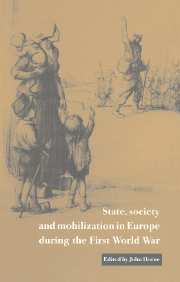Book contents
- Frontmatter
- Contents
- List of contributors
- Preface
- 1 Introduction: mobilizing for ‘total war’, 1914–1918
- I National ideals
- II Solidarities and minorities
- III Army and nation
- 8 Discipline and morale in the British army, 1917–1918
- 9 Remobilizing the citizen-soldier through the French army mutinies of 1917
- 10 The German army, the authoritarian nation-state and total war
- 11 Morale and patriotism in the Austro-Hungarian army, 1914–1918
- IV The limits and consequences of mobilization
- Notes
- Index
8 - Discipline and morale in the British army, 1917–1918
Published online by Cambridge University Press: 04 December 2009
- Frontmatter
- Contents
- List of contributors
- Preface
- 1 Introduction: mobilizing for ‘total war’, 1914–1918
- I National ideals
- II Solidarities and minorities
- III Army and nation
- 8 Discipline and morale in the British army, 1917–1918
- 9 Remobilizing the citizen-soldier through the French army mutinies of 1917
- 10 The German army, the authoritarian nation-state and total war
- 11 Morale and patriotism in the Austro-Hungarian army, 1914–1918
- IV The limits and consequences of mobilization
- Notes
- Index
Summary
‘The whole art of making war may be summed up in three words – courage, action, determination.’ So wrote the chief of the Imperial General Staff, Sir William Robertson, in November 1916. Robertson's extreme voluntarism, a reaction to the advent of modern firepower, was fully representative of thinking within the British military elite. The possibilities of modern weapons systems, though not denied, disturbed the ethos and values of an officer corps that gave primacy to human agency in the conduct of war. Machine-guns, mortars, automatic rifles and high-powered artillery were disliked, distrusted and undervalued. Assigned a subsidiary role, they were incorporated, grudgingly and clumsily, into the dominant soldier-centred framework of contemporary military analysis. Never was the tendency to hold fast to nurse more pronounced than among the Camberley cohort that reached seniority in the years that separated the South African War from the Great War. The revolution in firepower and the tactical–operational problems arising therefrom, far from provoking a fundamental reappraisal of practice and performance, served to emphasize the superiority of tradition over technology, character over intellect, manpower over machines, will-power over weaponry and the offensive over the defensive. Industrialized mass warfare had, if anything, rendered traditional conceptions of the human-oriented battlefield more rather than less useful. Intelligence, initiative and élan were never more relevant and the scope for personal valour was wider than ever. Napoleonic dicta on the ratio of the moral to the material were, indeed, in need of revision – but upwards, not downwards.
- Type
- Chapter
- Information
- Publisher: Cambridge University PressPrint publication year: 1997
- 4
- Cited by

